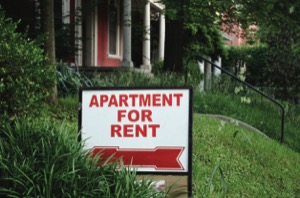
There are many reasons people choose to rent homes rather than to buy them.
They may be trying out an area, intending to live in an area for a short period of time. Or they may not have the down payment necessary to purchase a home and home prices may simply be too high. Those with significant savings, like seniors who have sold their family home, may find keeping a large bank account a hedge against lack of retirement income.
As a result, demand for rentals is high, especially on the coasts favored by millennials, and rent is accordingly pretty steep. Wages have not increased as significantly as rent, and in-demand markets like California claim almost half of a salary for rent. This is a major cause for keeping renters out of the purchase market, as it is exceedingly difficult to save for that down payment with rental costs eating up so much of the budget.
The growing percentage of renters in the marketplace may have a long term impact on real estate and the economy in general. Home buying offers a major boost to the economy, engendering purchase of home goods and services, and is a source of income for banks and financial institutions. With a slowdown in purchase ability, the sought after growth in the national GDP is potentially stymied.
Rental figures in San Diego have increased over 7 percent in the past year with a record high average of $1,875 last month. This is partly due to a paucity of apartment construction to meet demand, and whatever new units coming up falling in the luxury category.
It simply does not make financial sense to build affordable housing when the demand for high end rental is this strong. With initial costs for permitting and building luxury or affordable units the same, developers are choosing to spend the extras for upscale amenities for a lifetime of higher return.
Vacancy rates are close to zero, hovering in the 2-3 percent range. A recent survey showed the least expensive average rent in San Diego at approx. $1,400 for a studio of less than 500 square feet. But studios are difficult to come by, as two bedroom units comprise over 50 percent of all apartments in the county, with one bedrooms at just over 35 percent, leaving the remaining ultra-small studios and ultra-large three- and four-bedroom units to comprise the remaining 15 percent. It makes good sense for people looking for affordable rents to consider a roommate, or two.
So how can anyone find affordable living arrangements? One can consider a move to smaller, non-coastal cities like Pittsburgh, Houston, Madison, Oklahoma City and the like. Stay in California but live with others. The options are few.
As for saving for, and ultimately purchasing a home, this still remains the ultimate goal of many millennials. Whether this dream remains viable is dependent on many factors: whether mortgage interest and property taxes will continue to be tax deductible, whether prices come down a bit if they do not, and whether wages continue to stay flat or start to move upward. It’s all up in the air at the moment.
In the meantime, if you’re renting, enjoy keeping your money in the bank poised for the next opportunity that may come your way. The best part of renting is that it is a short commitment, and enables you to change your mind and move on, hopefully to even better shores.











